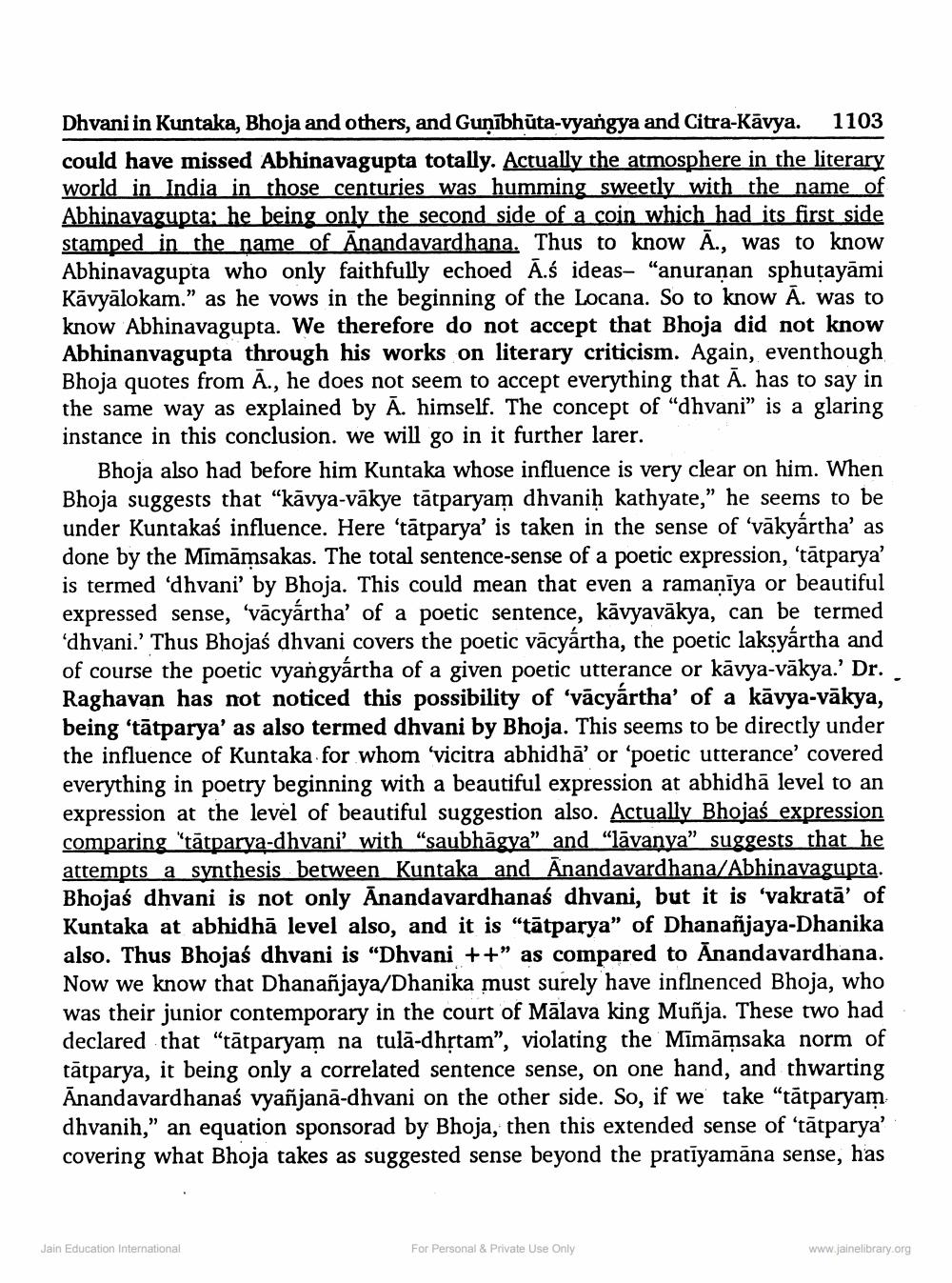________________
Dhvani in Kuntaka, Bhoja and others, and Gunībhūta-vyangya and Citra-Kavya.
1103
could have missed Abhinavagupta totally. Actually the atmosphere in the literary world in India in those centuries was humming sweetly with the name of Abhinavagupta; he being only the second side of a coin which had its first side stamped in the name of Anandavardhana. Thus to know A., was to know Abhinavagupta who only faithfully echoed A.ś ideas- "anuranan sphuṭayāmi Kāvyālokam." as he vows in the beginning of the Locana. So to know A. was to know Abhinavagupta. We therefore do not accept that Bhoja did not know Abhinanvagupta through his works on literary criticism. Again, eventhough Bhoja quotes from A., he does not seem to accept everything that A. has to say in the same way as explained by A. himself. The concept of "dhvani" is a glaring instance in this conclusion. we will go in it further larer.
Bhoja also had before him Kuntaka whose influence is very clear on him. When Bhoja suggests that "kavya-vākye tatparyam dhvaniḥ kathyate," he seems to be under Kuntakaś influence. Here 'tātparya' is taken in the sense of 'väkyártha' as done by the Mimāmsakas. The total sentence-sense of a poetic expression, 'tātparya' is termed 'dhvani' by Bhoja. This could mean that even a ramaṇīya or beautiful expressed sense, 'vacyártha' of a poetic sentence, kavyavākya, can be termed 'dhvani.' Thus Bhojaś dhvani covers the poetic vacyártha, the poetic lakṣyártha and of course the poetic vyangyártha of a given poetic utterance or kāvya-vākya.' Dr. . Raghavan has not noticed this possibility of 'vacyártha' of a kavya-vākya, being 'tātparya' as also termed dhvani by Bhoja. This seems to be directly under the influence of Kuntaka for whom 'vicitra abhidha' or 'poetic utterance' covered everything in poetry beginning with a beautiful expression at abhidhā level to an expression at the level of beautiful suggestion also. Actually Bhojas expression comparing "tatparya-dhvani' with "saubhagya" and "lavanya" suggests that he attempts a synthesis between Kuntaka and Anandavardhana/Abhinavagupta. Bhojaś dhvani is not only Anandavardhanaś dhvani, but it is 'vakrata' of Kuntaka at abhidhā level also, and it is "tātparya" of Dhanañjaya-Dhanika also. Thus Bhojaś dhvani is "Dhvani ++" as compared to Anandavardhana. Now we know that Dhananjaya/Dhanika must surely have inflnenced Bhoja, who was their junior contemporary in the court of Mālava king Muñja. These two had declared that "tātparyam na tula-dhṛtam", violating the Mimāmsaka norm of tātparya, it being only a correlated sentence sense, on one hand, and thwarting Anandavardhanaś vyañjanā-dhvani on the other side. So, if we take "tātparyam dhvanih," an equation sponsorad by Bhoja, then this extended sense of 'tātparya' covering what Bhoja takes as suggested sense beyond the pratīyamāna sense, has
Jain Education International
For Personal & Private Use Only
www.jainelibrary.org




